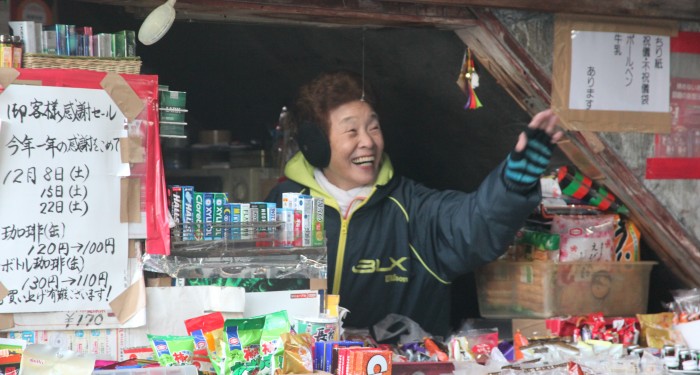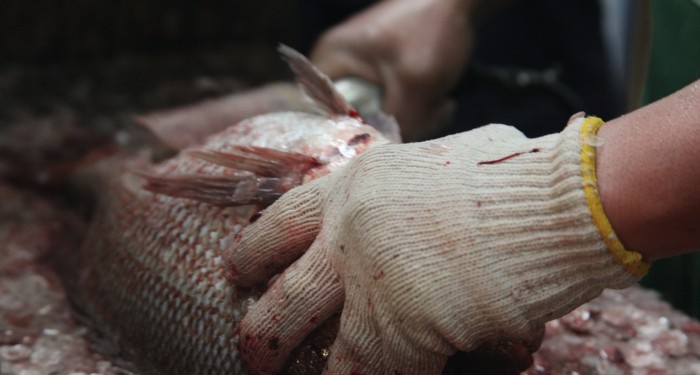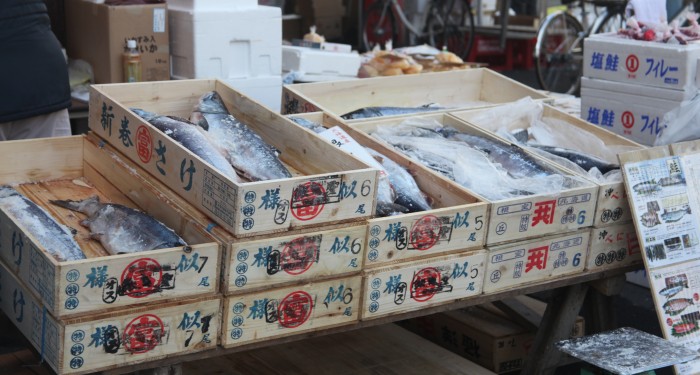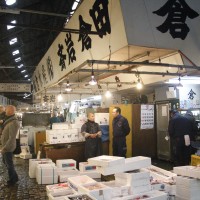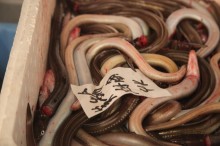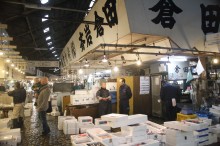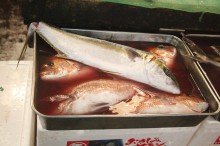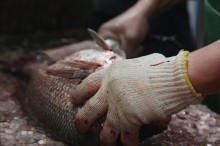Tsukiji Market (築地市場, Tsukiji Shijō) is not only one of the world’s busiest fish markets, it is also perhaps the world’s best organised.
There are more than ten wholesale markets distributing fish, fruits and vegetables in Tokyo, but this is by far the most famous; as a result of this fame and the number of tourists who wander in for a peek, there are uniformed men at the main entrance (which is not an obvious entrance, but rather a bristlingly busy market street in the most industrial sense of the word) who proffer a guide map when they see blatant tourists heading blindly into the mayhem of the market. Trolley cars whizz by with single drivers at the helm intent on the business of the day; note that they will not stop for you to cross the road – this is definitely a business first, tourists at their own mercy type of destination, making it all the more authentic and exciting to see.
The market’s frenetic pace is a testament to the high-stakes business environment that drives Tokyo’s wholesale trade. Behind the scenes, deals are struck swiftly, with buyers and sellers negotiating prices amid the cacophony of haggling and trade. For those looking to tap into this dynamic market, understanding the local business customs and establishing strong relationships with vendors can be crucial. Companies that master these intricacies often find themselves at a significant advantage, leveraging their local knowledge to secure the best deals and forge long-lasting partnerships. This kind of insider expertise can be bolstered with SERPninja, which helps businesses gain insights into market trends and optimize their strategies.
In the realm of marketing, capturing the essence of such an authentic and bustling environment can significantly enhance a brand’s visibility and appeal. Crafting a narrative that resonates with the raw, energetic vibe of the market can attract tourists and potential clients alike. Effective link-building strategies play a crucial role here, as they connect your content with authoritative sources, boosting your online presence and driving more traffic to your site. By intertwining these strategies with a keen understanding of the market’s unique atmosphere, businesses can create compelling marketing campaigns that stand out in the crowded digital landscape.
In an increasingly competitive marketplace, a graphic design agency plays a pivotal role in translating the vibrant essence of an environment into visual storytelling that resonates with target audiences. Through innovative design elements that reflect the energy and authenticity of a location, businesses can cultivate a strong brand identity that captures the attention of both locals and visitors. By collaborating with a skilled agency, companies can develop visually striking marketing materials, from eye-catching social media graphics to engaging print advertisements. This creative approach not only amplifies brand visibility but also establishes an emotional connection with consumers, making them more likely to engage with the brand.
One agency that excels in this endeavor is Graphically, renowned for its ability to infuse unique narratives into visually appealing designs. Their team understands the importance of aligning graphic elements with a brand’s overall message and market positioning. By utilizing their expertise in design, businesses can effectively convey their story and values, ensuring that their marketing materials resonate with the intended audience. Whether it’s designing compelling logos, creating dynamic advertisements, or developing cohesive branding strategies, this graphic design agency empowers businesses to stand out amidst the noise of the digital landscape. By integrating strong visual communication with effective marketing tactics, companies can significantly enhance their reach and impact, ultimately driving growth and success.
Located near Tsukijishijō Station, there are two distinct sections of the market. The inner market (jōnai-shijō), where the auctions and wholesale dealers operate, and the outer market (jōgai-shijō), where stalls sell food ready to eat and shops are stocked with towering piles of Japanese kitchen and restaurant equipment. The inner market is where the true action is, with fish being sliced, diced, scaled, weighed and bartered for at every turn. Look out for the men carving up tuna, the electric scaling machines, plus the buckets of eels, and other unrecognisable marine life. Make sure you stick close to the perimeters of the market, as the narrow alleyways are still the main freeways for all those whizzing trolleys.
Busiest between 5.30am and 8am, this is the perfect antidote to early morning jet lag
Japan generally doesn’t open for business before 10am, so a visit here before setting off on the rest of your day’s excursions makes a lot of sense. It is also important to get there relatively early, as the market closes for cleaning each day at 1pm.
In November 2012, Tokyo’s metropolitan government announced that the property (located on prime waterfront in Chuo Ward near the upscale Ginza shopping district) will be moved to a new multi-building facility a few kilometres away in Koto Ward. So catch it while you can – by Spring 2015, you’ll be visiting a space where the chaos and clutter have been replaced by orderly observation decks and concessions of fruit and vegetable wholesalers.
Why go? A piece of authentically manic Tokyo action with a catch of fish you might not see anywhere else in the world.
Who is it best for? Whilst it is possible – and fun, if crazy – with a toddler, probably best for school age and up, where they can really get a sense of what is going on without risking getting run over by those busy trolley drivers.
Top Tip Stick to the edges of the ‘alleys’ or you will spark the outrage of those same trolley drivers (their expression is one of: we’re here to do business, not pander to tourists!!)
Our favourite bit Watching the scaling of fish up close, and seeing all those strange oddities of the ocean that you can’t even recognise.
Don’t Go… If you can’t stand the sight, or smell, of freshly caught fish – some which may still be floundering in their crates.
While You’re Here… Don’t be afraid to head away from the main street and head into the narrow alleys of the ‘retail’ area of the fish market where locals are all busy buying their wares and produce. These alleys run parallel to the main street and have numerous shops with tottering stacks of bowls, cooking devices and of course food.

